ICT705 Data Integration: EIA Reference Architecture Report 2018
VerifiedAdded on 2023/06/12
|12
|2605
|174
Report
AI Summary
This report examines the benefits of an Enterprise Information Architecture Reference Architecture (EIA RA) for the Australian federal government in developing a national HER system. It discusses the strategic management of IT resources, infrastructure considerations, and the importance of aligning IT strategy. The report addresses challenges related to heterogeneous data, storage capacity, bad data, and cost factors, proposing strategies for mitigation. It concludes by emphasizing the importance of continuous system updates, proper planning, risk identification, and careful implementation to ensure the success and long-term benefits of data integration projects. The document is available on Desklib, a platform offering study tools and solved assignments for students.
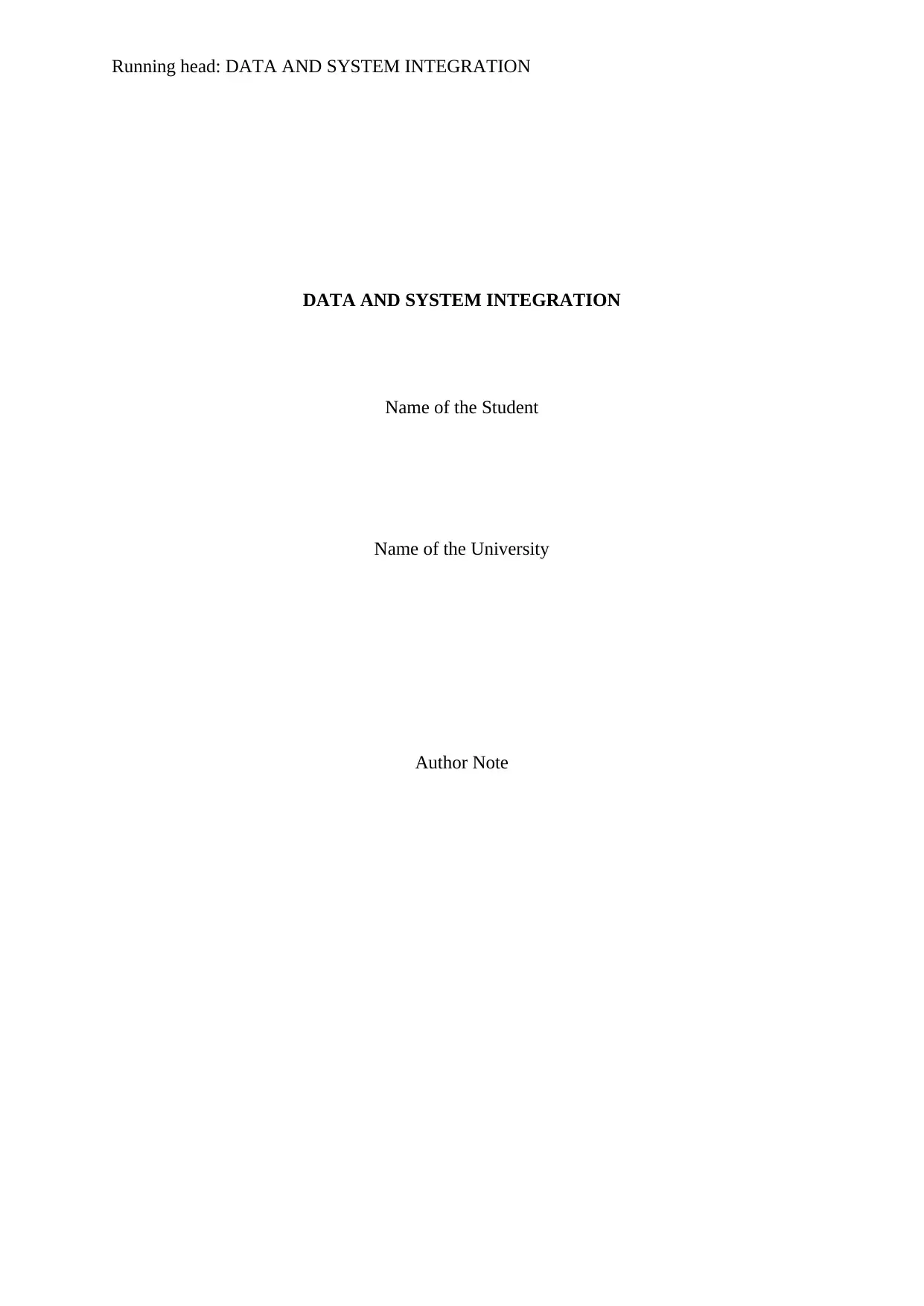
Running head: DATA AND SYSTEM INTEGRATION
DATA AND SYSTEM INTEGRATION
Name of the Student
Name of the University
Author Note
DATA AND SYSTEM INTEGRATION
Name of the Student
Name of the University
Author Note
Paraphrase This Document
Need a fresh take? Get an instant paraphrase of this document with our AI Paraphraser
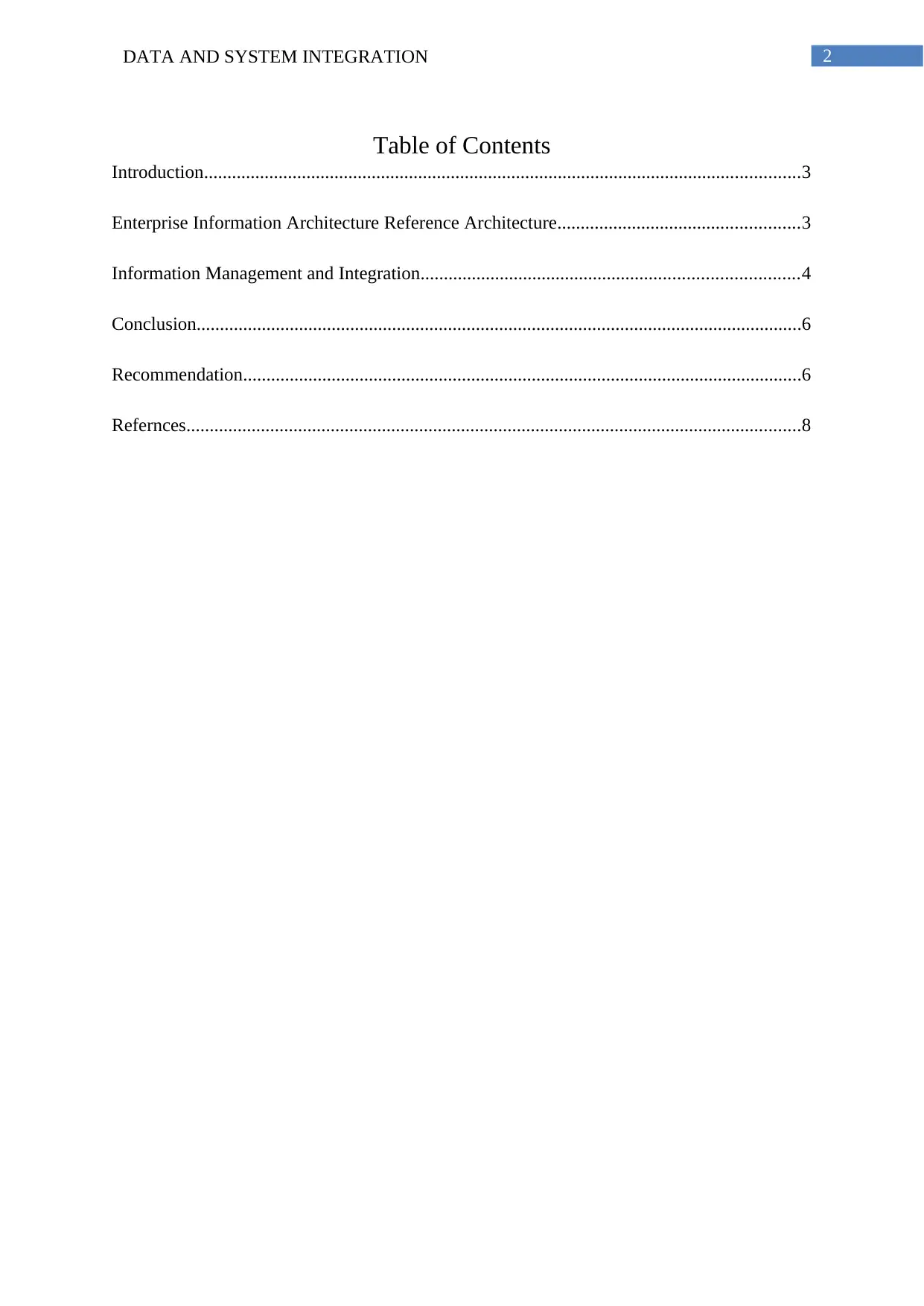
2DATA AND SYSTEM INTEGRATION
Table of Contents
Introduction................................................................................................................................3
Enterprise Information Architecture Reference Architecture....................................................3
Information Management and Integration.................................................................................4
Conclusion..................................................................................................................................6
Recommendation........................................................................................................................6
Refernces....................................................................................................................................8
Table of Contents
Introduction................................................................................................................................3
Enterprise Information Architecture Reference Architecture....................................................3
Information Management and Integration.................................................................................4
Conclusion..................................................................................................................................6
Recommendation........................................................................................................................6
Refernces....................................................................................................................................8
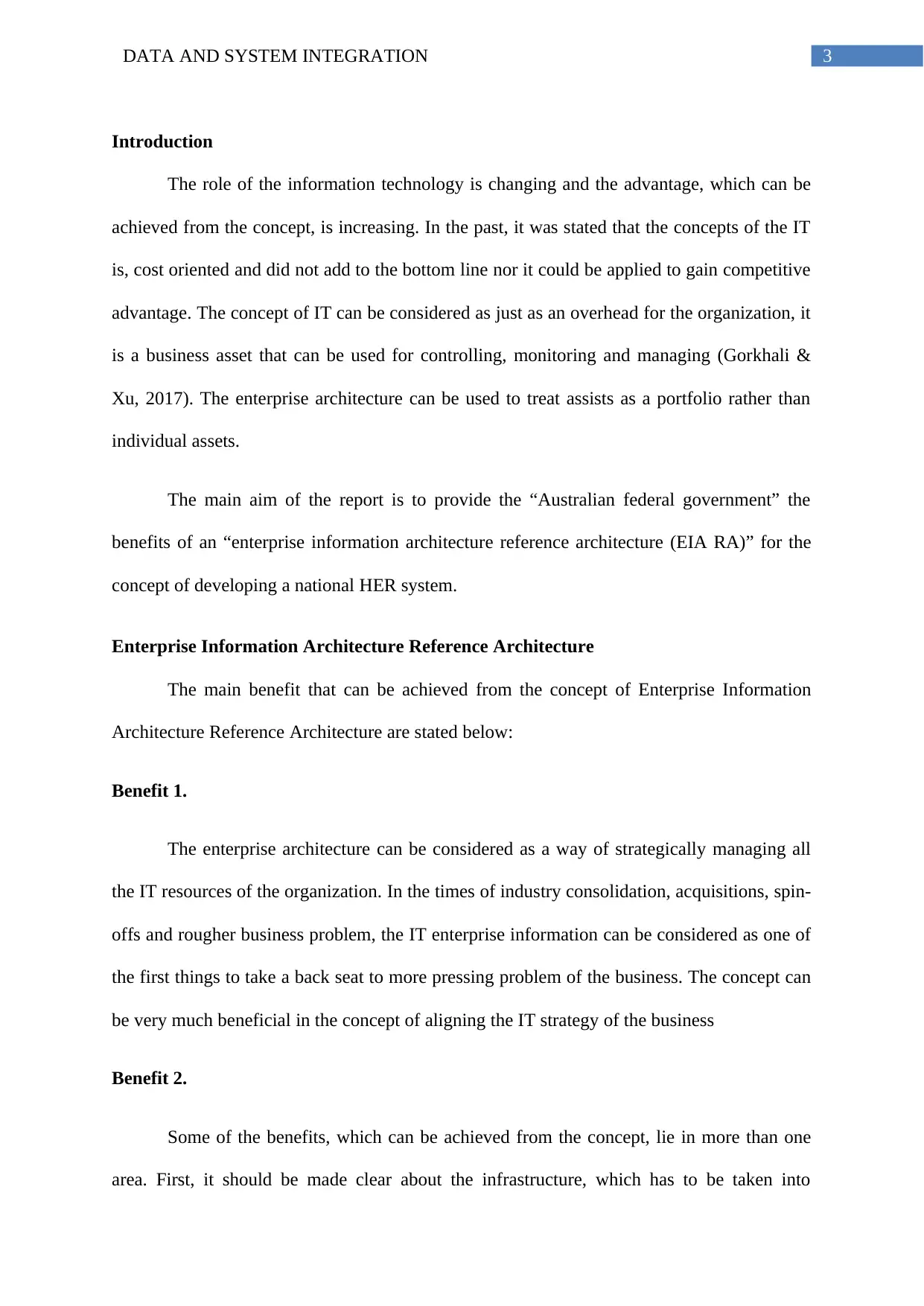
3DATA AND SYSTEM INTEGRATION
Introduction
The role of the information technology is changing and the advantage, which can be
achieved from the concept, is increasing. In the past, it was stated that the concepts of the IT
is, cost oriented and did not add to the bottom line nor it could be applied to gain competitive
advantage. The concept of IT can be considered as just as an overhead for the organization, it
is a business asset that can be used for controlling, monitoring and managing (Gorkhali &
Xu, 2017). The enterprise architecture can be used to treat assists as a portfolio rather than
individual assets.
The main aim of the report is to provide the “Australian federal government” the
benefits of an “enterprise information architecture reference architecture (EIA RA)” for the
concept of developing a national HER system.
Enterprise Information Architecture Reference Architecture
The main benefit that can be achieved from the concept of Enterprise Information
Architecture Reference Architecture are stated below:
Benefit 1.
The enterprise architecture can be considered as a way of strategically managing all
the IT resources of the organization. In the times of industry consolidation, acquisitions, spin-
offs and rougher business problem, the IT enterprise information can be considered as one of
the first things to take a back seat to more pressing problem of the business. The concept can
be very much beneficial in the concept of aligning the IT strategy of the business
Benefit 2.
Some of the benefits, which can be achieved from the concept, lie in more than one
area. First, it should be made clear about the infrastructure, which has to be taken into
Introduction
The role of the information technology is changing and the advantage, which can be
achieved from the concept, is increasing. In the past, it was stated that the concepts of the IT
is, cost oriented and did not add to the bottom line nor it could be applied to gain competitive
advantage. The concept of IT can be considered as just as an overhead for the organization, it
is a business asset that can be used for controlling, monitoring and managing (Gorkhali &
Xu, 2017). The enterprise architecture can be used to treat assists as a portfolio rather than
individual assets.
The main aim of the report is to provide the “Australian federal government” the
benefits of an “enterprise information architecture reference architecture (EIA RA)” for the
concept of developing a national HER system.
Enterprise Information Architecture Reference Architecture
The main benefit that can be achieved from the concept of Enterprise Information
Architecture Reference Architecture are stated below:
Benefit 1.
The enterprise architecture can be considered as a way of strategically managing all
the IT resources of the organization. In the times of industry consolidation, acquisitions, spin-
offs and rougher business problem, the IT enterprise information can be considered as one of
the first things to take a back seat to more pressing problem of the business. The concept can
be very much beneficial in the concept of aligning the IT strategy of the business
Benefit 2.
Some of the benefits, which can be achieved from the concept, lie in more than one
area. First, it should be made clear about the infrastructure, which has to be taken into
⊘ This is a preview!⊘
Do you want full access?
Subscribe today to unlock all pages.

Trusted by 1+ million students worldwide
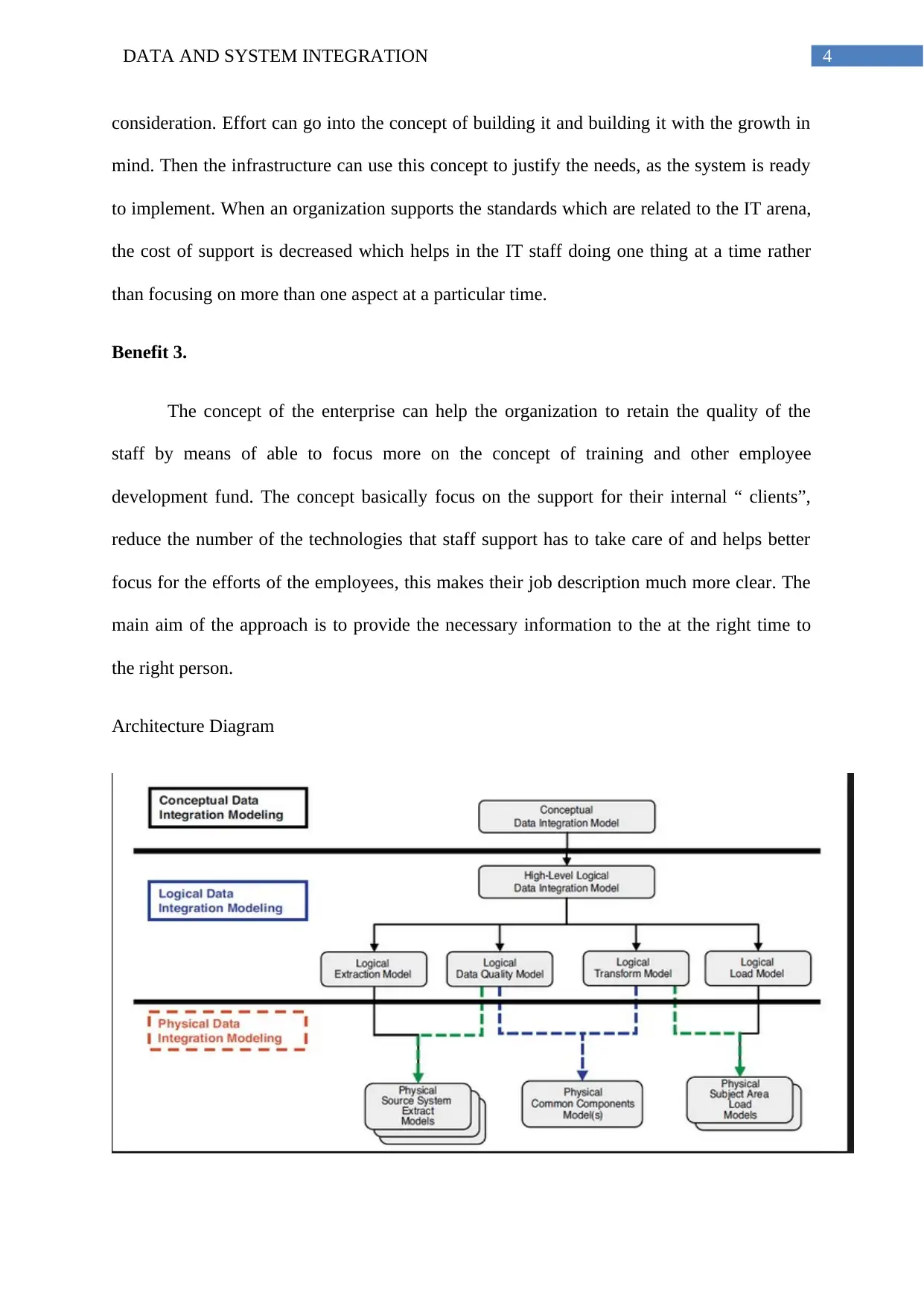
4DATA AND SYSTEM INTEGRATION
consideration. Effort can go into the concept of building it and building it with the growth in
mind. Then the infrastructure can use this concept to justify the needs, as the system is ready
to implement. When an organization supports the standards which are related to the IT arena,
the cost of support is decreased which helps in the IT staff doing one thing at a time rather
than focusing on more than one aspect at a particular time.
Benefit 3.
The concept of the enterprise can help the organization to retain the quality of the
staff by means of able to focus more on the concept of training and other employee
development fund. The concept basically focus on the support for their internal “ clients”,
reduce the number of the technologies that staff support has to take care of and helps better
focus for the efforts of the employees, this makes their job description much more clear. The
main aim of the approach is to provide the necessary information to the at the right time to
the right person.
Architecture Diagram
consideration. Effort can go into the concept of building it and building it with the growth in
mind. Then the infrastructure can use this concept to justify the needs, as the system is ready
to implement. When an organization supports the standards which are related to the IT arena,
the cost of support is decreased which helps in the IT staff doing one thing at a time rather
than focusing on more than one aspect at a particular time.
Benefit 3.
The concept of the enterprise can help the organization to retain the quality of the
staff by means of able to focus more on the concept of training and other employee
development fund. The concept basically focus on the support for their internal “ clients”,
reduce the number of the technologies that staff support has to take care of and helps better
focus for the efforts of the employees, this makes their job description much more clear. The
main aim of the approach is to provide the necessary information to the at the right time to
the right person.
Architecture Diagram
Paraphrase This Document
Need a fresh take? Get an instant paraphrase of this document with our AI Paraphraser
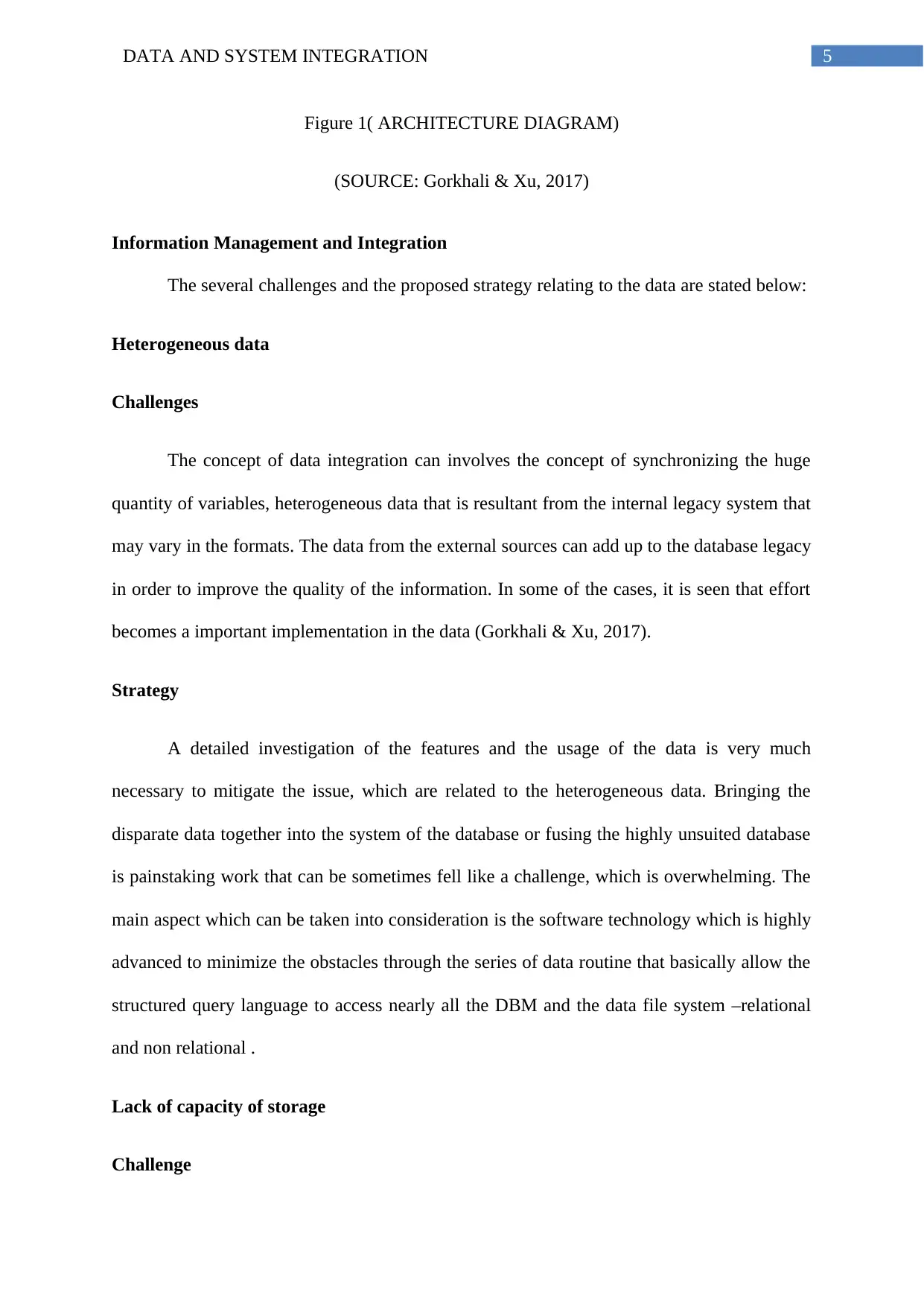
5DATA AND SYSTEM INTEGRATION
Figure 1( ARCHITECTURE DIAGRAM)
(SOURCE: Gorkhali & Xu, 2017)
Information Management and Integration
The several challenges and the proposed strategy relating to the data are stated below:
Heterogeneous data
Challenges
The concept of data integration can involves the concept of synchronizing the huge
quantity of variables, heterogeneous data that is resultant from the internal legacy system that
may vary in the formats. The data from the external sources can add up to the database legacy
in order to improve the quality of the information. In some of the cases, it is seen that effort
becomes a important implementation in the data (Gorkhali & Xu, 2017).
Strategy
A detailed investigation of the features and the usage of the data is very much
necessary to mitigate the issue, which are related to the heterogeneous data. Bringing the
disparate data together into the system of the database or fusing the highly unsuited database
is painstaking work that can be sometimes fell like a challenge, which is overwhelming. The
main aspect which can be taken into consideration is the software technology which is highly
advanced to minimize the obstacles through the series of data routine that basically allow the
structured query language to access nearly all the DBM and the data file system –relational
and non relational .
Lack of capacity of storage
Challenge
Figure 1( ARCHITECTURE DIAGRAM)
(SOURCE: Gorkhali & Xu, 2017)
Information Management and Integration
The several challenges and the proposed strategy relating to the data are stated below:
Heterogeneous data
Challenges
The concept of data integration can involves the concept of synchronizing the huge
quantity of variables, heterogeneous data that is resultant from the internal legacy system that
may vary in the formats. The data from the external sources can add up to the database legacy
in order to improve the quality of the information. In some of the cases, it is seen that effort
becomes a important implementation in the data (Gorkhali & Xu, 2017).
Strategy
A detailed investigation of the features and the usage of the data is very much
necessary to mitigate the issue, which are related to the heterogeneous data. Bringing the
disparate data together into the system of the database or fusing the highly unsuited database
is painstaking work that can be sometimes fell like a challenge, which is overwhelming. The
main aspect which can be taken into consideration is the software technology which is highly
advanced to minimize the obstacles through the series of data routine that basically allow the
structured query language to access nearly all the DBM and the data file system –relational
and non relational .
Lack of capacity of storage
Challenge
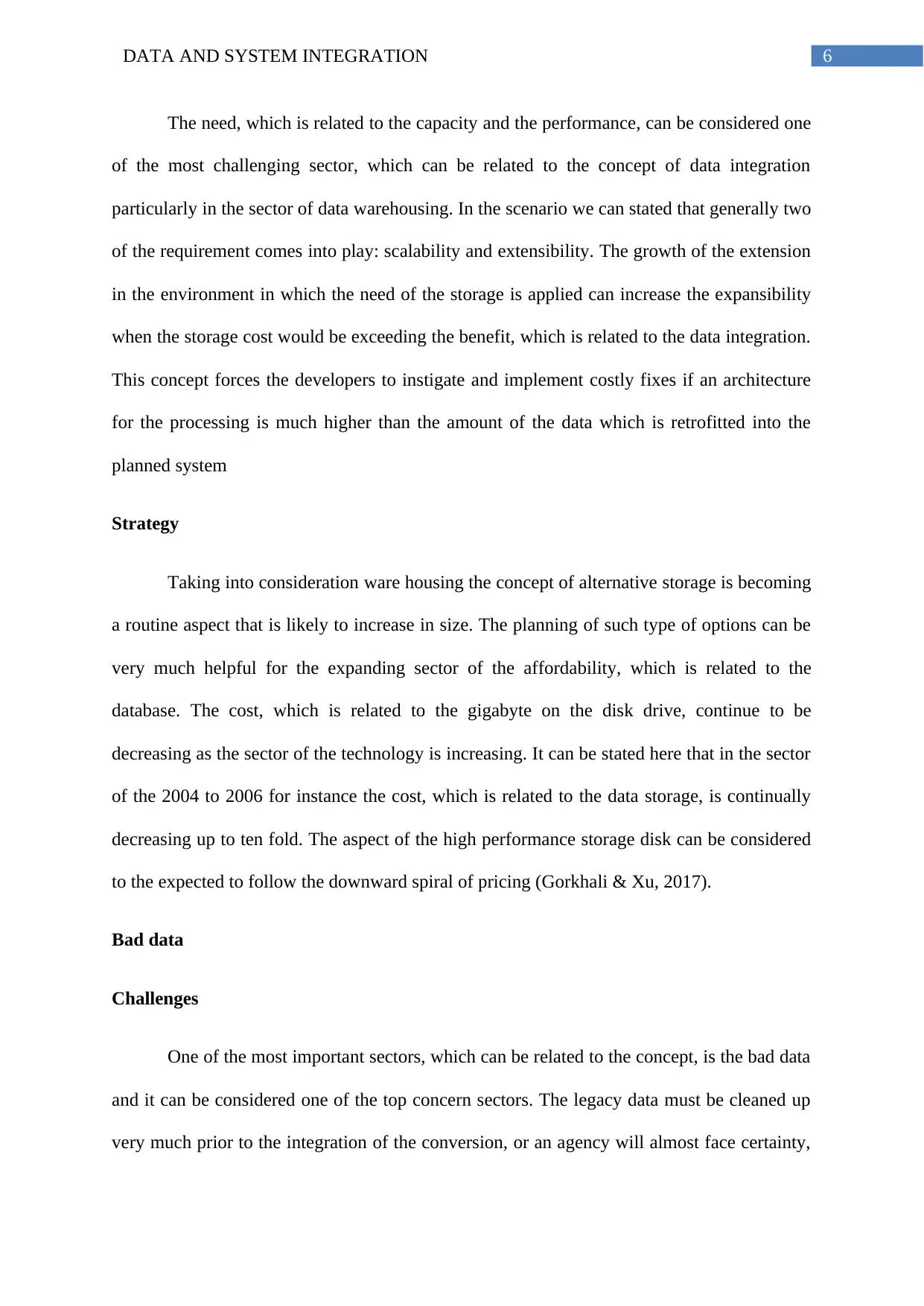
6DATA AND SYSTEM INTEGRATION
The need, which is related to the capacity and the performance, can be considered one
of the most challenging sector, which can be related to the concept of data integration
particularly in the sector of data warehousing. In the scenario we can stated that generally two
of the requirement comes into play: scalability and extensibility. The growth of the extension
in the environment in which the need of the storage is applied can increase the expansibility
when the storage cost would be exceeding the benefit, which is related to the data integration.
This concept forces the developers to instigate and implement costly fixes if an architecture
for the processing is much higher than the amount of the data which is retrofitted into the
planned system
Strategy
Taking into consideration ware housing the concept of alternative storage is becoming
a routine aspect that is likely to increase in size. The planning of such type of options can be
very much helpful for the expanding sector of the affordability, which is related to the
database. The cost, which is related to the gigabyte on the disk drive, continue to be
decreasing as the sector of the technology is increasing. It can be stated here that in the sector
of the 2004 to 2006 for instance the cost, which is related to the data storage, is continually
decreasing up to ten fold. The aspect of the high performance storage disk can be considered
to the expected to follow the downward spiral of pricing (Gorkhali & Xu, 2017).
Bad data
Challenges
One of the most important sectors, which can be related to the concept, is the bad data
and it can be considered one of the top concern sectors. The legacy data must be cleaned up
very much prior to the integration of the conversion, or an agency will almost face certainty,
The need, which is related to the capacity and the performance, can be considered one
of the most challenging sector, which can be related to the concept of data integration
particularly in the sector of data warehousing. In the scenario we can stated that generally two
of the requirement comes into play: scalability and extensibility. The growth of the extension
in the environment in which the need of the storage is applied can increase the expansibility
when the storage cost would be exceeding the benefit, which is related to the data integration.
This concept forces the developers to instigate and implement costly fixes if an architecture
for the processing is much higher than the amount of the data which is retrofitted into the
planned system
Strategy
Taking into consideration ware housing the concept of alternative storage is becoming
a routine aspect that is likely to increase in size. The planning of such type of options can be
very much helpful for the expanding sector of the affordability, which is related to the
database. The cost, which is related to the gigabyte on the disk drive, continue to be
decreasing as the sector of the technology is increasing. It can be stated here that in the sector
of the 2004 to 2006 for instance the cost, which is related to the data storage, is continually
decreasing up to ten fold. The aspect of the high performance storage disk can be considered
to the expected to follow the downward spiral of pricing (Gorkhali & Xu, 2017).
Bad data
Challenges
One of the most important sectors, which can be related to the concept, is the bad data
and it can be considered one of the top concern sectors. The legacy data must be cleaned up
very much prior to the integration of the conversion, or an agency will almost face certainty,
⊘ This is a preview!⊘
Do you want full access?
Subscribe today to unlock all pages.

Trusted by 1+ million students worldwide
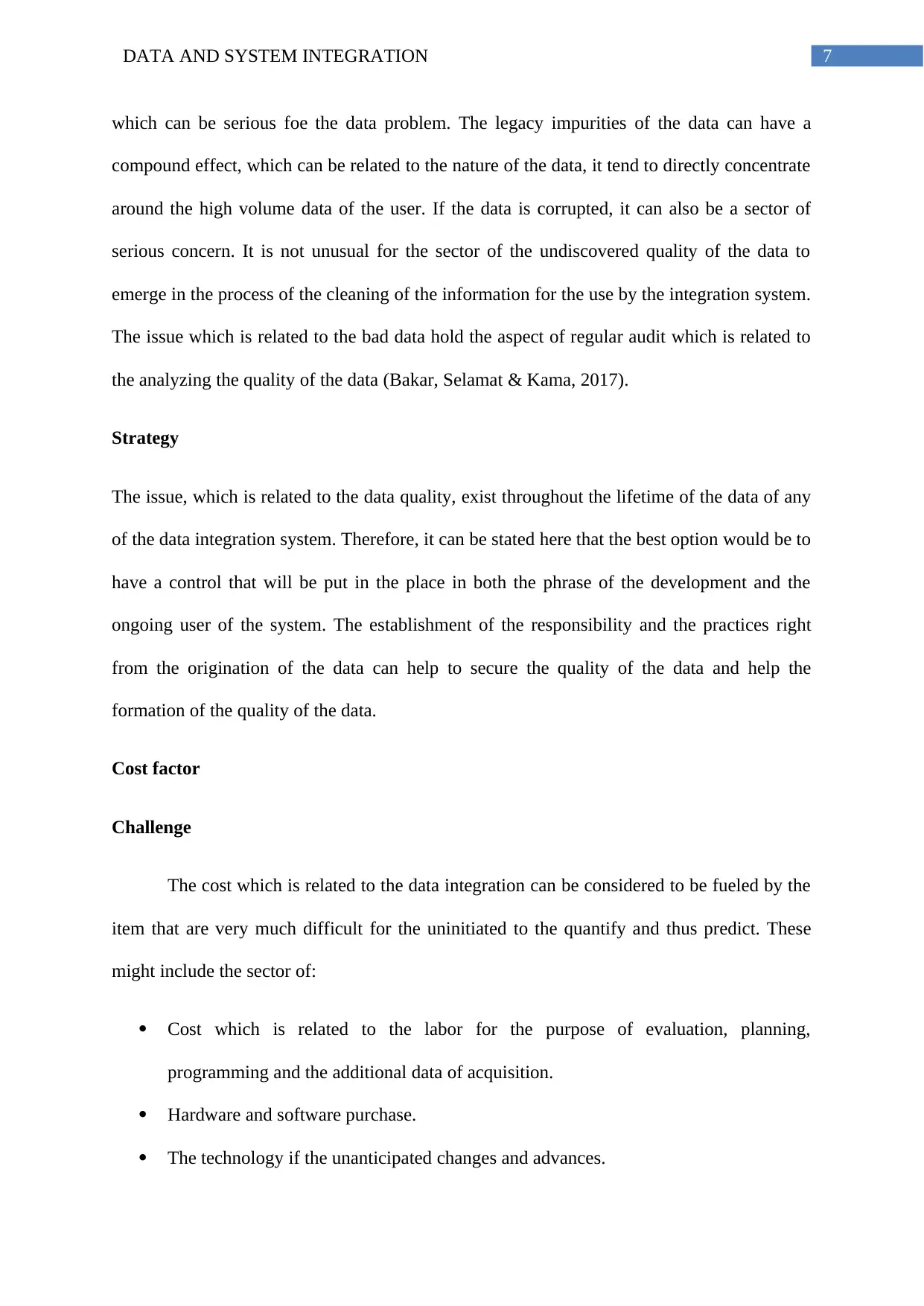
7DATA AND SYSTEM INTEGRATION
which can be serious foe the data problem. The legacy impurities of the data can have a
compound effect, which can be related to the nature of the data, it tend to directly concentrate
around the high volume data of the user. If the data is corrupted, it can also be a sector of
serious concern. It is not unusual for the sector of the undiscovered quality of the data to
emerge in the process of the cleaning of the information for the use by the integration system.
The issue which is related to the bad data hold the aspect of regular audit which is related to
the analyzing the quality of the data (Bakar, Selamat & Kama, 2017).
Strategy
The issue, which is related to the data quality, exist throughout the lifetime of the data of any
of the data integration system. Therefore, it can be stated here that the best option would be to
have a control that will be put in the place in both the phrase of the development and the
ongoing user of the system. The establishment of the responsibility and the practices right
from the origination of the data can help to secure the quality of the data and help the
formation of the quality of the data.
Cost factor
Challenge
The cost which is related to the data integration can be considered to be fueled by the
item that are very much difficult for the uninitiated to the quantify and thus predict. These
might include the sector of:
Cost which is related to the labor for the purpose of evaluation, planning,
programming and the additional data of acquisition.
Hardware and software purchase.
The technology if the unanticipated changes and advances.
which can be serious foe the data problem. The legacy impurities of the data can have a
compound effect, which can be related to the nature of the data, it tend to directly concentrate
around the high volume data of the user. If the data is corrupted, it can also be a sector of
serious concern. It is not unusual for the sector of the undiscovered quality of the data to
emerge in the process of the cleaning of the information for the use by the integration system.
The issue which is related to the bad data hold the aspect of regular audit which is related to
the analyzing the quality of the data (Bakar, Selamat & Kama, 2017).
Strategy
The issue, which is related to the data quality, exist throughout the lifetime of the data of any
of the data integration system. Therefore, it can be stated here that the best option would be to
have a control that will be put in the place in both the phrase of the development and the
ongoing user of the system. The establishment of the responsibility and the practices right
from the origination of the data can help to secure the quality of the data and help the
formation of the quality of the data.
Cost factor
Challenge
The cost which is related to the data integration can be considered to be fueled by the
item that are very much difficult for the uninitiated to the quantify and thus predict. These
might include the sector of:
Cost which is related to the labor for the purpose of evaluation, planning,
programming and the additional data of acquisition.
Hardware and software purchase.
The technology if the unanticipated changes and advances.
Paraphrase This Document
Need a fresh take? Get an instant paraphrase of this document with our AI Paraphraser
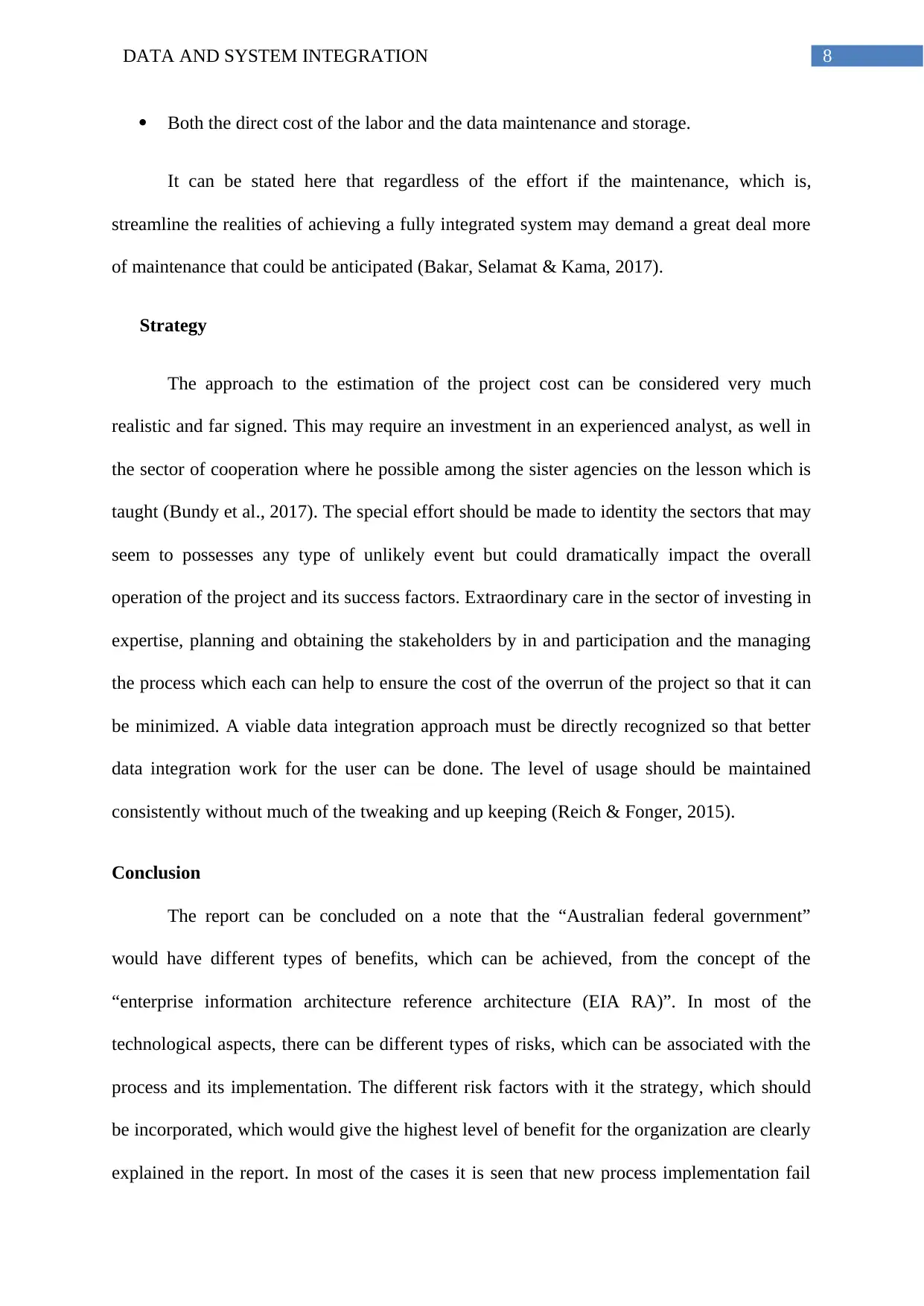
8DATA AND SYSTEM INTEGRATION
Both the direct cost of the labor and the data maintenance and storage.
It can be stated here that regardless of the effort if the maintenance, which is,
streamline the realities of achieving a fully integrated system may demand a great deal more
of maintenance that could be anticipated (Bakar, Selamat & Kama, 2017).
Strategy
The approach to the estimation of the project cost can be considered very much
realistic and far signed. This may require an investment in an experienced analyst, as well in
the sector of cooperation where he possible among the sister agencies on the lesson which is
taught (Bundy et al., 2017). The special effort should be made to identity the sectors that may
seem to possesses any type of unlikely event but could dramatically impact the overall
operation of the project and its success factors. Extraordinary care in the sector of investing in
expertise, planning and obtaining the stakeholders by in and participation and the managing
the process which each can help to ensure the cost of the overrun of the project so that it can
be minimized. A viable data integration approach must be directly recognized so that better
data integration work for the user can be done. The level of usage should be maintained
consistently without much of the tweaking and up keeping (Reich & Fonger, 2015).
Conclusion
The report can be concluded on a note that the “Australian federal government”
would have different types of benefits, which can be achieved, from the concept of the
“enterprise information architecture reference architecture (EIA RA)”. In most of the
technological aspects, there can be different types of risks, which can be associated with the
process and its implementation. The different risk factors with it the strategy, which should
be incorporated, which would give the highest level of benefit for the organization are clearly
explained in the report. In most of the cases it is seen that new process implementation fail
Both the direct cost of the labor and the data maintenance and storage.
It can be stated here that regardless of the effort if the maintenance, which is,
streamline the realities of achieving a fully integrated system may demand a great deal more
of maintenance that could be anticipated (Bakar, Selamat & Kama, 2017).
Strategy
The approach to the estimation of the project cost can be considered very much
realistic and far signed. This may require an investment in an experienced analyst, as well in
the sector of cooperation where he possible among the sister agencies on the lesson which is
taught (Bundy et al., 2017). The special effort should be made to identity the sectors that may
seem to possesses any type of unlikely event but could dramatically impact the overall
operation of the project and its success factors. Extraordinary care in the sector of investing in
expertise, planning and obtaining the stakeholders by in and participation and the managing
the process which each can help to ensure the cost of the overrun of the project so that it can
be minimized. A viable data integration approach must be directly recognized so that better
data integration work for the user can be done. The level of usage should be maintained
consistently without much of the tweaking and up keeping (Reich & Fonger, 2015).
Conclusion
The report can be concluded on a note that the “Australian federal government”
would have different types of benefits, which can be achieved, from the concept of the
“enterprise information architecture reference architecture (EIA RA)”. In most of the
technological aspects, there can be different types of risks, which can be associated with the
process and its implementation. The different risk factors with it the strategy, which should
be incorporated, which would give the highest level of benefit for the organization are clearly
explained in the report. In most of the cases it is seen that new process implementation fail
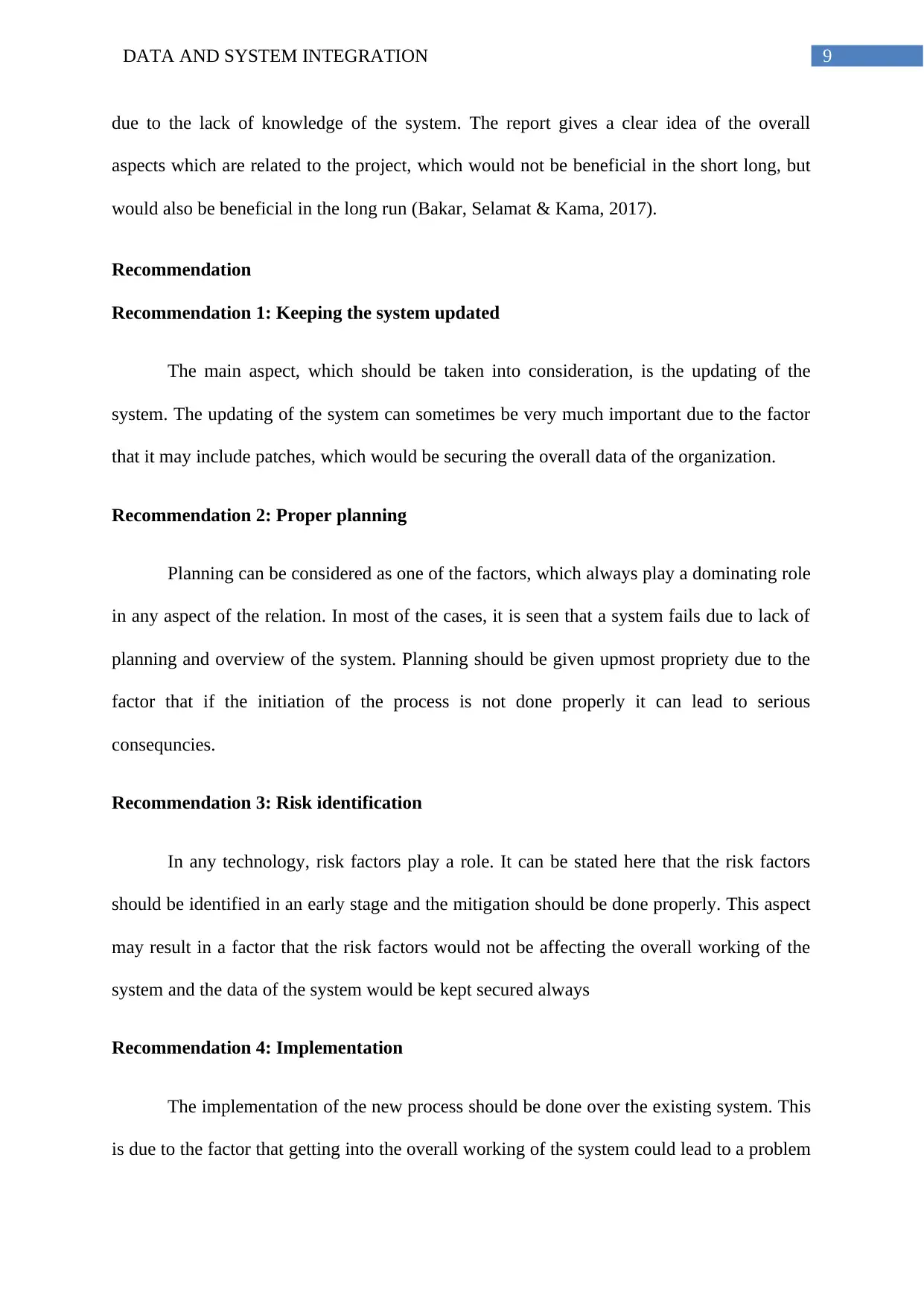
9DATA AND SYSTEM INTEGRATION
due to the lack of knowledge of the system. The report gives a clear idea of the overall
aspects which are related to the project, which would not be beneficial in the short long, but
would also be beneficial in the long run (Bakar, Selamat & Kama, 2017).
Recommendation
Recommendation 1: Keeping the system updated
The main aspect, which should be taken into consideration, is the updating of the
system. The updating of the system can sometimes be very much important due to the factor
that it may include patches, which would be securing the overall data of the organization.
Recommendation 2: Proper planning
Planning can be considered as one of the factors, which always play a dominating role
in any aspect of the relation. In most of the cases, it is seen that a system fails due to lack of
planning and overview of the system. Planning should be given upmost propriety due to the
factor that if the initiation of the process is not done properly it can lead to serious
consequncies.
Recommendation 3: Risk identification
In any technology, risk factors play a role. It can be stated here that the risk factors
should be identified in an early stage and the mitigation should be done properly. This aspect
may result in a factor that the risk factors would not be affecting the overall working of the
system and the data of the system would be kept secured always
Recommendation 4: Implementation
The implementation of the new process should be done over the existing system. This
is due to the factor that getting into the overall working of the system could lead to a problem
due to the lack of knowledge of the system. The report gives a clear idea of the overall
aspects which are related to the project, which would not be beneficial in the short long, but
would also be beneficial in the long run (Bakar, Selamat & Kama, 2017).
Recommendation
Recommendation 1: Keeping the system updated
The main aspect, which should be taken into consideration, is the updating of the
system. The updating of the system can sometimes be very much important due to the factor
that it may include patches, which would be securing the overall data of the organization.
Recommendation 2: Proper planning
Planning can be considered as one of the factors, which always play a dominating role
in any aspect of the relation. In most of the cases, it is seen that a system fails due to lack of
planning and overview of the system. Planning should be given upmost propriety due to the
factor that if the initiation of the process is not done properly it can lead to serious
consequncies.
Recommendation 3: Risk identification
In any technology, risk factors play a role. It can be stated here that the risk factors
should be identified in an early stage and the mitigation should be done properly. This aspect
may result in a factor that the risk factors would not be affecting the overall working of the
system and the data of the system would be kept secured always
Recommendation 4: Implementation
The implementation of the new process should be done over the existing system. This
is due to the factor that getting into the overall working of the system could lead to a problem
⊘ This is a preview!⊘
Do you want full access?
Subscribe today to unlock all pages.

Trusted by 1+ million students worldwide
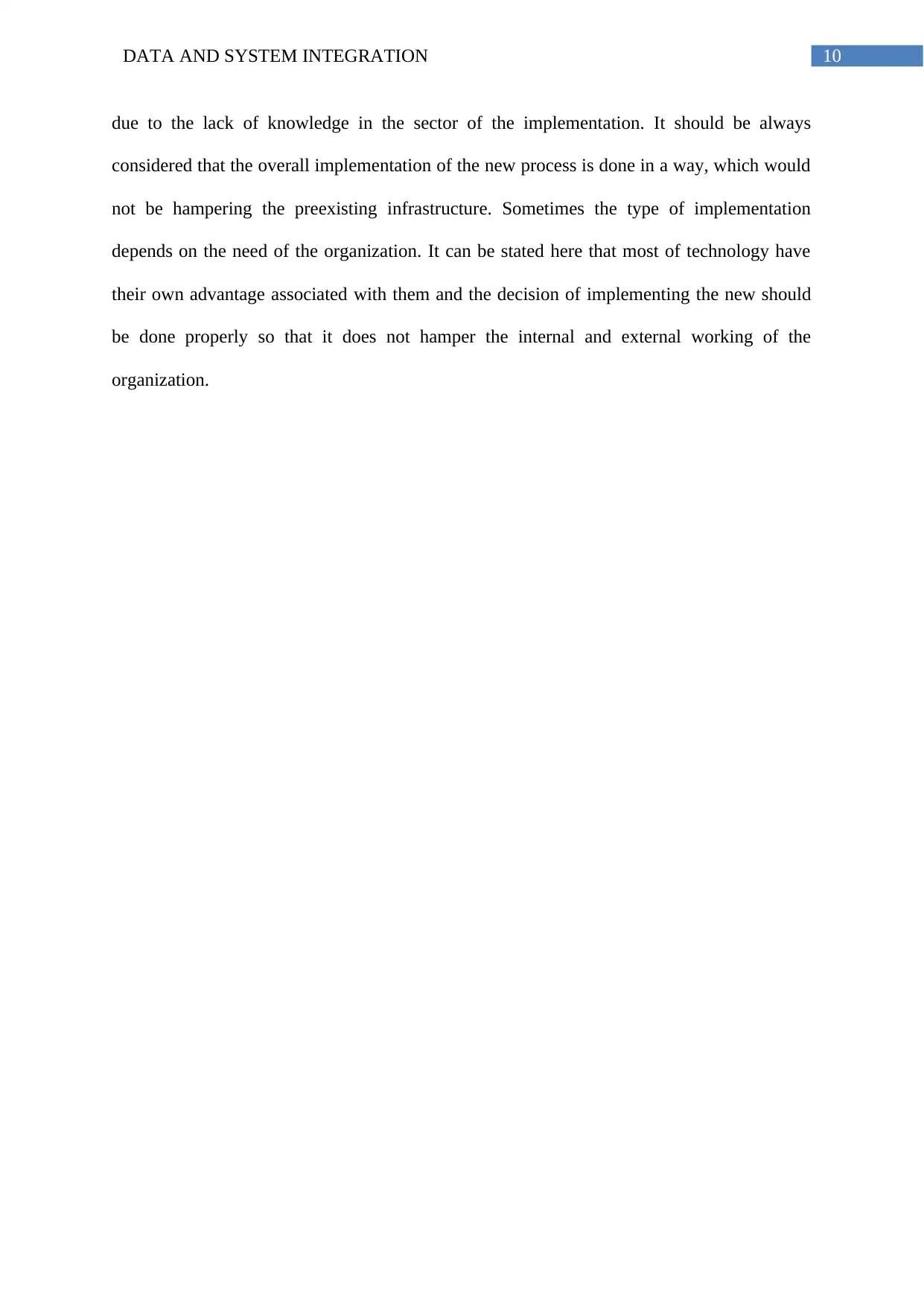
10DATA AND SYSTEM INTEGRATION
due to the lack of knowledge in the sector of the implementation. It should be always
considered that the overall implementation of the new process is done in a way, which would
not be hampering the preexisting infrastructure. Sometimes the type of implementation
depends on the need of the organization. It can be stated here that most of technology have
their own advantage associated with them and the decision of implementing the new should
be done properly so that it does not hamper the internal and external working of the
organization.
due to the lack of knowledge in the sector of the implementation. It should be always
considered that the overall implementation of the new process is done in a way, which would
not be hampering the preexisting infrastructure. Sometimes the type of implementation
depends on the need of the organization. It can be stated here that most of technology have
their own advantage associated with them and the decision of implementing the new should
be done properly so that it does not hamper the internal and external working of the
organization.
Paraphrase This Document
Need a fresh take? Get an instant paraphrase of this document with our AI Paraphraser
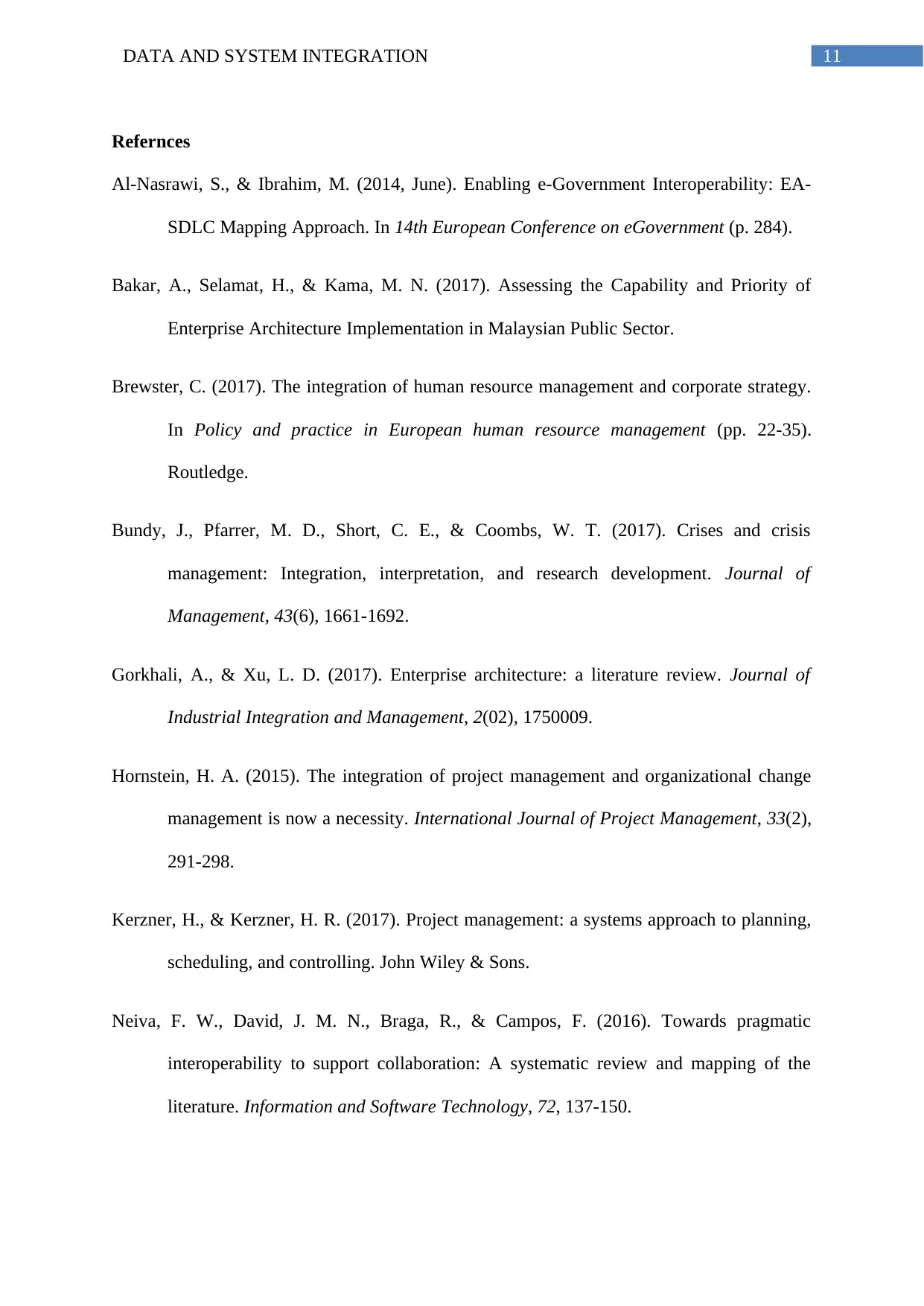
11DATA AND SYSTEM INTEGRATION
Refernces
Al-Nasrawi, S., & Ibrahim, M. (2014, June). Enabling e-Government Interoperability: EA-
SDLC Mapping Approach. In 14th European Conference on eGovernment (p. 284).
Bakar, A., Selamat, H., & Kama, M. N. (2017). Assessing the Capability and Priority of
Enterprise Architecture Implementation in Malaysian Public Sector.
Brewster, C. (2017). The integration of human resource management and corporate strategy.
In Policy and practice in European human resource management (pp. 22-35).
Routledge.
Bundy, J., Pfarrer, M. D., Short, C. E., & Coombs, W. T. (2017). Crises and crisis
management: Integration, interpretation, and research development. Journal of
Management, 43(6), 1661-1692.
Gorkhali, A., & Xu, L. D. (2017). Enterprise architecture: a literature review. Journal of
Industrial Integration and Management, 2(02), 1750009.
Hornstein, H. A. (2015). The integration of project management and organizational change
management is now a necessity. International Journal of Project Management, 33(2),
291-298.
Kerzner, H., & Kerzner, H. R. (2017). Project management: a systems approach to planning,
scheduling, and controlling. John Wiley & Sons.
Neiva, F. W., David, J. M. N., Braga, R., & Campos, F. (2016). Towards pragmatic
interoperability to support collaboration: A systematic review and mapping of the
literature. Information and Software Technology, 72, 137-150.
Refernces
Al-Nasrawi, S., & Ibrahim, M. (2014, June). Enabling e-Government Interoperability: EA-
SDLC Mapping Approach. In 14th European Conference on eGovernment (p. 284).
Bakar, A., Selamat, H., & Kama, M. N. (2017). Assessing the Capability and Priority of
Enterprise Architecture Implementation in Malaysian Public Sector.
Brewster, C. (2017). The integration of human resource management and corporate strategy.
In Policy and practice in European human resource management (pp. 22-35).
Routledge.
Bundy, J., Pfarrer, M. D., Short, C. E., & Coombs, W. T. (2017). Crises and crisis
management: Integration, interpretation, and research development. Journal of
Management, 43(6), 1661-1692.
Gorkhali, A., & Xu, L. D. (2017). Enterprise architecture: a literature review. Journal of
Industrial Integration and Management, 2(02), 1750009.
Hornstein, H. A. (2015). The integration of project management and organizational change
management is now a necessity. International Journal of Project Management, 33(2),
291-298.
Kerzner, H., & Kerzner, H. R. (2017). Project management: a systems approach to planning,
scheduling, and controlling. John Wiley & Sons.
Neiva, F. W., David, J. M. N., Braga, R., & Campos, F. (2016). Towards pragmatic
interoperability to support collaboration: A systematic review and mapping of the
literature. Information and Software Technology, 72, 137-150.
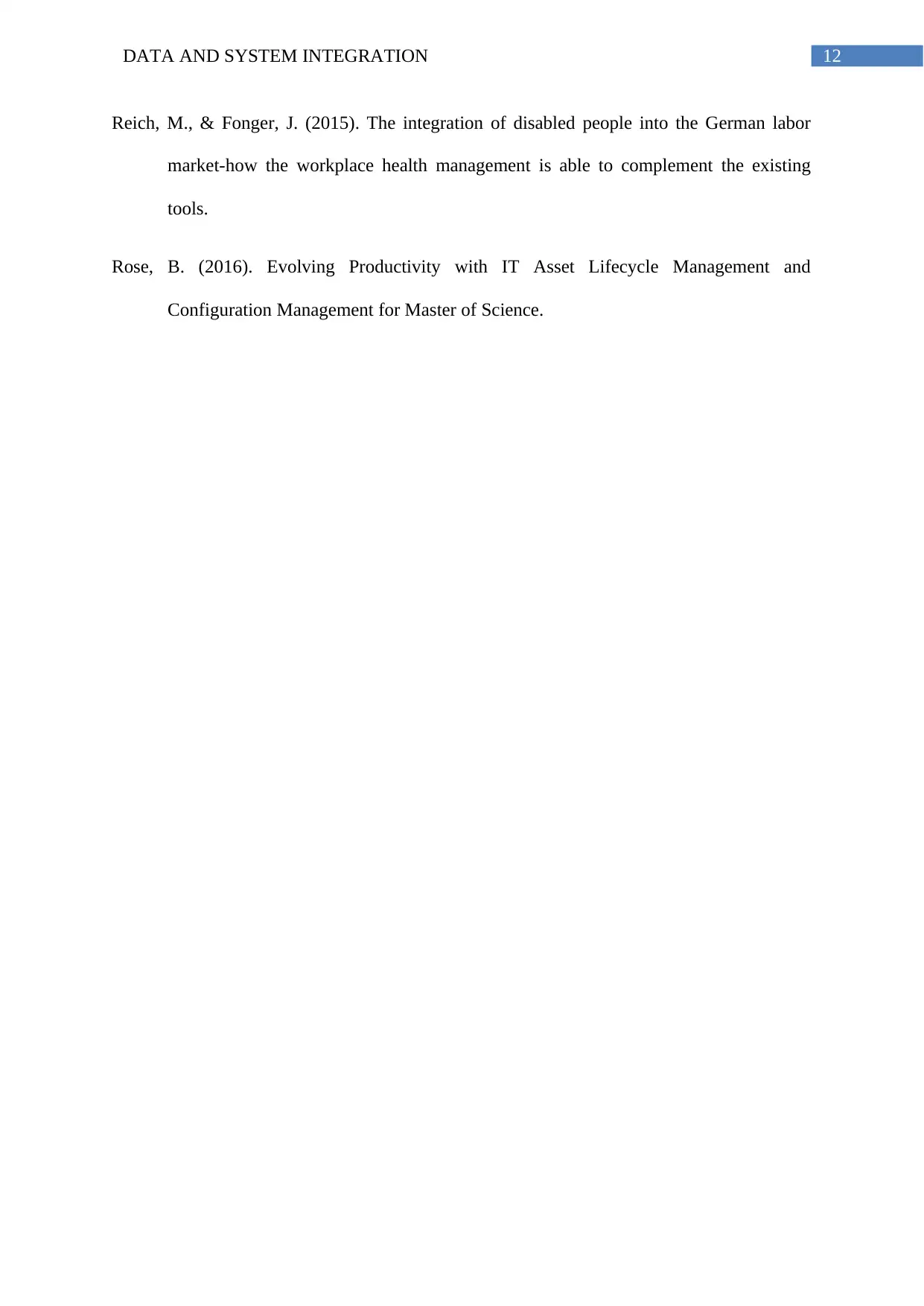
12DATA AND SYSTEM INTEGRATION
Reich, M., & Fonger, J. (2015). The integration of disabled people into the German labor
market-how the workplace health management is able to complement the existing
tools.
Rose, B. (2016). Evolving Productivity with IT Asset Lifecycle Management and
Configuration Management for Master of Science.
Reich, M., & Fonger, J. (2015). The integration of disabled people into the German labor
market-how the workplace health management is able to complement the existing
tools.
Rose, B. (2016). Evolving Productivity with IT Asset Lifecycle Management and
Configuration Management for Master of Science.
⊘ This is a preview!⊘
Do you want full access?
Subscribe today to unlock all pages.

Trusted by 1+ million students worldwide
1 out of 12
Related Documents
Your All-in-One AI-Powered Toolkit for Academic Success.
+13062052269
info@desklib.com
Available 24*7 on WhatsApp / Email
![[object Object]](/_next/static/media/star-bottom.7253800d.svg)
Unlock your academic potential
Copyright © 2020–2025 A2Z Services. All Rights Reserved. Developed and managed by ZUCOL.





